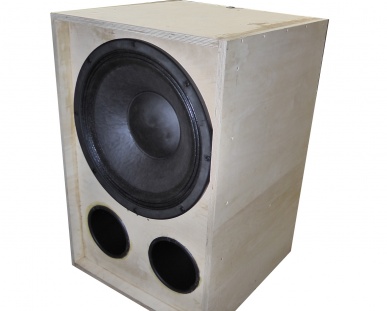
Celestion have designed a ported bass cabinet, specifically for use with the CF18VJD ferrite magnet, cast aluminium LF driver. Cabinet specifications are:
Material: 18mm birch plywood
Cabinet Volume: 167 litres (5.9 cu. ft.) total / 135 litres (4.8 cu. ft.) effective
Cabinet Resonance (Fb): 37Hz
Max SPL (1-watt/1m): 127dB (-0.5dB at 40Hz, -3dB at 36.5Hz)
Recommended high pass filter: Butterworth 24 dB/octave, 33Hz cut-off
For detailed dimensions and a cut-out guide, see the attached PDF document below.
Bass Reflex
A ported or reflex cabinet is a simple box enclosure with one or more holes (ports) added on the front baffle. For most PA uses, this offers the best option for building a clean sounding loudspeaker cabinet that makes the most of the bass driver used. The addition of the port can extend bass driver performance and will also marginally improve the speaker’s low frequency power handling and efficiency.
The energy from the front of the driver is radiated to the outside world. But the sound from the back of the speaker also has an effect, as it vibrates the air in the port(s). This has a resonant frequency, like an organ pipe, adding to the sound output of the system. If the port(s) are designed correctly, the additional energy will extend bass performance without adding distortion or sacrificing a smooth response.
High Pass Filter
As with all ported boxes, it would be sensible to use with a high pass filter. This will ensure that no high level input is presented to the box below its lower limit. This is because, for very low frequency signals, the driver becomes unloaded, (i.e. the box effectively disappears.) Under these circumstances, driver excursion increases rapidly and the potential for driver damage is significant. For this CF18VJD cabinet, a suitable value for this filter is 33 Hz. A sharp corner to the cut-off would be desirable, so a 24 dB/octave Butterworth filter or similar is recommended.
Cabinet Build
The cabinet should be built as a solid and non-resonant box with well sealed and secured joints. This particular design uses 18mm plywood: the advantages of this are strength, durability and availability. The panel joints shown are simple butt joints that are screwed and glued. For those with advanced woodworking skills, more sophisticated joints can be used. Whatever joint type you use, it is important they are secure and airtight.
In addition, to reduce panel resonances, bracing battens have been added.
Connectors and Accessories
Electrical connectors such as high quality 1/4-inch jacks, 4mm binding posts, XLRs or a speakon can be used. When fitting these, mount the socket then make airtight using a sealing compound. Use mounting bolts and T-nuts to fix the driver to the baffle. CF18VJD is compatible with M6 bolts.
There is a wide range of speaker cabinet accessories available, including wheels, hands, grilles and corners, adding to convenience and durability. These should be fitted carefully so as not to weaken the box or cause leaks.
For more details download the attached PDF file.

